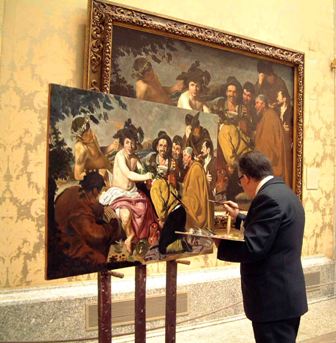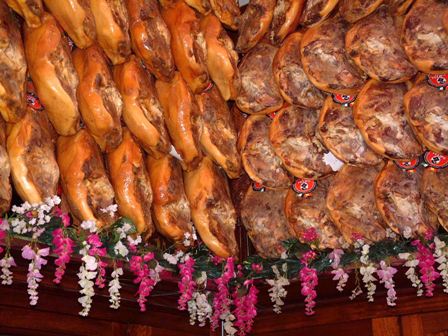MADRID: A CITY FOR ROMANTICS AND OF TAPAS BARS
By Ray Chatelin

A sidewalk guitarist playing near the King's Palace
Anyone calling himself a Romantic eventually must come to grips with Spain. For Spain is a place of pleasures audible and visible, of gentle music and ancient architecture, the writings of Cervantes, the paintings of Picasso and Goya, of Flamenco dance and music.
And it's in Madrid where it all comes together. For in this city are pieces of the country's complex puzzle. Like Canada, it's a country of vast parts, with each of its eight provinces different from its neighbors, and each – as I discover whenever I'm in the country - is incredibly proud of its distinction.
Spain's capital is a passionate city, different from Paris in its character, but with the same sense of mystery that you find in Istanbul. It is filled with great art and music, wonderful cafes, and like the rest of the country, it's also a time capsule, where layers of Christian and Moslem cultures are literally built upon one another.
Like all major cities, Madrid has many parts and to adequately experience them all takes most of a lifetime.
The heart of the city—and Spain itself it can be argued—begins at Madrid's Puerta del Sol, the center of downtown and the point from which all distances in the country are calculated. It was reputedly named for a gate (Puerta) that stood there until 1510 and had on its front a representation of the sun (sol).
Madrid is a place that begs for walking. For to understand this wonderful, complex town, you must absorb it in small sections - frequent the tapas bars, spend time just sitting around the picturesque squares, slowly allow the city's richness of character to permeate your mind.
I never tire of walking the web of narrow downtown streets that radiate from the Puerto del Sol, especially after 8 pm every night, when a mass of joyous humanity fills cafes, musicians on play on street corners and lovers walk arm in arm.
Cozy Tapas bars permeate the area with their variety of Spanish appetizers, most cooked in olive oil and garlic and impossible to resist. If Spanish isn't your language, it's no matter. Many owners speak English and, if not, all you need do is point to what you want.
Most tapas bars look somewhat messy, but that's because Spaniards throw soiled napkins and olive pits on the floor by their feet since it's considered impolite to leave them on your plate. Years ago, as a first timer to Spanish etiquette, I was sometimes the target of curious smiles before finally getting the message.
One of the most charismatic tapas bars in in the city is La Torre del Oro in the Plaza Mayor, the city's historic central square not far from the Puerto del Sol. There, you'll find a history of bull fighting on the walls with photos and mementos from and about great matadors like El Cordoba, Antonio Ordoñez, or Curro Romero.
Try rabo del toro (bull tail soup) and eat among the dramatic photos, many of which are graphic insights into the dangerous life of matadors.

An artist recreating art at Madrid's Prado Museum
Major sites like the Prado Museum, offer private tours at a modest cost; and at the Reina Sofia, where you'll find Picasso's Guernica.
But there are so many small museums and art galleries around the city, they're too numerous to explore all in one visit. Ever been to a ham museum? There's one in the city's old town.

Hams hanging from the ceiling at the Ham Museum (Museo del Jamon)
Stop at the Plaza de Santa Anna across from the National Theatre and people-watch from one of the several outdoor cafes that ring the picturesque plaza; shop at the nearby flea market; spend an entire day looking though streets that surround the 17th Century Plaza Mayor, the original city palace.
Walking around old Madrid in the downtown core, is a delightful exploration of 17th Century palaces, mansions and churches.
For something completely different, take an informative and entertaining personal tour of the city center (limit 8 persons) from the Wellington Society where Stephen Drake-Jones leads informative and irreverent tours of the inner city. He's an authority on old Madrid and historic towns and cities throughout Spain, having lived in Spain since before the fall of Francisco Franco, the former dictator who died in 1975 at the age of 82.
Getting around the city is easy. The subway system is easy to use, inexpensive, and cuts through all areas of the city. But, bring a pair of comfortable walking shoes for your visit because every subway stop presents a myriad of reasons for a good walk.
_________________________
IF YOU GO:
National Tourism Office of Spain: https://www.spain.info/en/
The Wellington Society: http://www.wellsoc.org
The Ham Museum: http://www.museodeljamon.com/
Prado Museum: https://www.museodelprado.es/en/visit-the-museum
Reina Sophia: http://www.museoreinasofia.es/portada/portada.php
Photos by Toshi